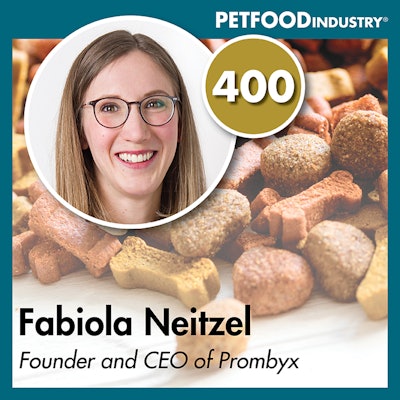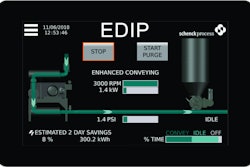
Founder and CEO of Prombyx Fabiola Neitzel sat down with me to discuss the growing interest in insect protein in the pet food industry. We chatted about the differences between Europe and North America markets, the expansion of insect options, and what the future may hold for the segment. Listen in to find out more!
The below transcript is from Episode 22 of the Trending: Pet Food podcast, where I spoke with Founder and CEO of Prombyx Fabiola Neitzel about the future of insect protein in the pet food industry. You can find the episode at www.PetfoodIndustry.com/trending-pet-food-podcast, on SoundCloud or on your favorite podcast platform. This episode originally aired on November 23, 2022.
Lindsay Beaton – Editor, Petfood Industry magazine and Host, Trending: Pet Food podcast
Hello, and welcome to Trending: Pet Food, the industry podcast where we cover all the latest hot topics and trends in pet food. I'm your host and Editor of Petfood Industry magazine, Lindsay Beaton, and I'm here today with Founder and CEO of Prombyx Fabiola Neitzel. Hi, Fabiola, and welcome.
Fabiola Neitzel – Founder and CEO, Prombyx
Hi, Lindsay.
Beaton: In case you're not familiar with Fabiola and her company, here's what you need to know. She has a Bachelor's of Applied Science and Food Management and a Master's of Science in Insect Technology and Bio Resources. Her undergraduate thesis involved experiments on insect feeding in cooperation with Bugs International, so it's really no surprise that she ended up co-founding Prombyx in January 2021 with her father, Dr. Reinhold Neitzel.
Prombyx is a Germany-based insect protein company with a focus on silkworms as ingredients for business-to-business feed producers in order to make use of the already existing byproduct of silk production. The name "Prombyx" comes from combining the words "protein" and "Bombyx mori," the Latin name of the silkworm.
Fabiola's knowledge of insect protein, as well as her company's growing presence in the European insect protein space, is why I've brought her on to help me answer today's question: What is the future of insect protein in the pet food industry?
I want to start today by talking about the evolution of insect protein in pet food, because it's something that really has gathered quite a bit of steam in the last few years. From your perspective, how has the idea of insect protein and pet food changed over the last several years?
Neitzel: I think that what people feed to their pets is very much related to what they eat themselves. And so I think we see all the trends evolving in human nutrition, again in pet food, and we have the trends of like vegan food, reducing meat consumption, also like functional foods. Since insect protein was also promoted for human nutrition, and became more popular and more known during the last few years, people are also more likely to feed insects to their pets. I think they're more familiar with the concept of insects as a protein source in general.
Beaton: Do you think people are more willing to use insect protein or accept insect protein as an idea of an ingredient in their pet food than they are for themselves? Or is the growth of acceptance going hand in hand?
Neitzel: There's definitely a link between what consumers eat themselves and what they would feed their pets. But also, we see that consumers are more okay with feeding insects to their animals than eating it themselves, since the “yuck factor” is not that big in what they feed to their animals than what they eat themselves. We all know that animals have different nutritional needs than we do, and insects are part of the natural food sources of dogs and cats. So I think, yes, consumers do accept insects, even more in the pet food than they accept it for their own nutrition.
Beaton: Europe is a little bit ahead of North America in terms of insect protein acceptance, in terms of both human food and pet food, honestly. What is the current state of insect protein acceptance in the European pet food market? What are consumers currently saying about how they feel about the situation overall, and what they're willing to accept, and even the kinds of formats they're willing to accept? Is it easier for them to, say, accept insect protein in a treat or in a dry food than it would be in a wet food? Are there certain things that they're more interested in than they used to be?
Neitzel: What we definitely see is that almost every European feed producer has at least one insect-based product in their range. So I think the trend is definitely there. You cannot deny it. But there's one problem the feed producers [have faced] for years and years: They told the consumers that the more meat the better. The more meat, the higher quality, the more premium the food would be. So consumers started to believe that and it went to a point where there's even way more meat in the pet food than what is healthy for the dog. It would actually be healthier for the dog to have reduced protein and meat content in the pet food. But many consumers now think, "My dog needs a lot and lots of meat and the more meat the better."
I think some consumers are more difficult than others to convince to use insect protein instead of meat protein. Other consumers are very curious. And they are probably very much aware of the climate change and the environmental impact of meat production. So if they do not eat meat or reduce their meat consumption themselves, why should they feed so much meat to their animal? I think there are two sides actually to this question.
Beaton: Since you've just touched on it, I want to dive into it a little bit more. One of the big reasons that insect protein is becoming a more viable ingredient in the pet food space has to do a lot with sustainability, alternative proteins, eco-consciousness ... Can you get a little bit more into why insect protein suits those trends so well, and fits the need for sustainable agriculture for alternative protein sources? Everything that insect protein keeps popping up in these conversations.
Neitzel: Yes, as you mentioned, there are many aspects that speak for insect protein. One big topic is the ethical side. So we know of course that traditional livestock is much more aware of their living conditions and of their rearing than the insects. So most insects love to be crowded. But besides their very close environment, they are not aware of what's going on. Traditional livestock will probably not feel too good in their environment when being captured. So I think from an ethical side, why should we rear livestock, the traditional livestock to feed it to our pets, so we treat the animals very different. And with insects, we do not have this problem. Of course, it is important to also consider animal welfare with insects, but they have very different perceptions of their surroundings. So this is one point. So if you love animals, you love your pet, you will for sure also think of the livestock.
Then we can definitely see that in terms of feed conversion rate, in terms of space, of water use, land use, insects are much more suitable and much more environmentally friendly. They do not need that many resources, they do not produce that much methane, CO2, it's definitely a much more sustainable source of protein.
Last but not least, consumers, especially pet food consumers, are always eager for innovation. So if there's a new product on the market, they like to try new things.
And one more point is we see more and more allergies in pets, especially meat allergies. So already today, a lot of pet owners have to look for very exotic sources of protein, very exotic meat sources, and for them insect protein can be a solution.
Beaton: We've been talking about insect protein as an umbrella term. And I want to dive into the specific types of insect protein that are being used right now and then talk a little bit more about what Prombyx uses, which is silkworm protein. Can you give kind of a summary of the different kinds of insect protein that are being used right now and then where silkworm protein fits into that picture?
Neitzel: Sure. I'm actually very happy about this question, since usually, at least in Europe, if you look at a product with insects, it does normally not say which type of insect it contains. It only says “insect protein,” but there are so many different insects on this planet. So we do not write "mammal meat" on a meat product, why should we write "insect" or "insect protein" on an insect protein product? So I'm very much a fan of naming the actual species of insect. Right now for sure the most used insect for protein production is the black soldier fly, Hermetia illucens. I think this is due to the rearing conditions. It fits on a lot of different rearing substrates. Not all, but quite a lot. So it makes it very suitable for insect mass production. Probably in second place there's the yellow mealworm, Tenebrio molitor. Third place I would say is the house cricket, Acheta domesticus. But for sure the black soldier fly is most common.
Beaton: Black soldier fly definitely seems to be the one that has gotten the most press. And like you said, it seems to be very suitable for this alternative protein, sustainability, insect protein segment growth. What are some of the advantages of different kinds of insect protein that made companies and made the segment look at other types of insects? And then what is it specifically about silkworm protein that fits into this whole landscape of various insect proteins and pet food?
Neitzel: Every insect species has a very different or very unique profile of nutrients. So we all are familiar with the concept of different types of meat. We all know that beef is different from chicken and chicken is different from pork. However, the idea that insect protein from different insect species can be very different is not yet that common. But that's in fact the case. Not only do the amino acid profiles differ from species to species, but also the fatty acid profile can be very different. So I think for various nutritional needs, and depending on what pet we are looking at — are we looking at cats, at dogs, at birds, at reptiles, at fish — they all have different nutritional needs. And we can meet these needs with different insect species. So, for example, black soldier fly contains a lot of lauric acid, they have fatty acid profile; the fatty acid profile of silkworms is very different, silkworms contain mainly mono- and polyunsaturated fatty acids. Also, the amino acid profile is different in the silkworms. So I think it's worth it to have a closer look on the specific nutritional profiles of the different insect species and match them with the nutritional needs of our pets.
Beaton: Does that mean that various insect proteins could be used in different functional applications based on their profiles?
Neitzel: Absolutely, I think so. One thing that is also a topic of research is different health benefits from different insect proteins or not only the proteins, also the fatty acids. I think there's a lot to discover.
Beaton: What is some of the current research going on? Either research you guys are conducting or research that you're aware of or following? Because there really is quite a bit of research going on in the insect protein space, particularly in Europe. And it's been really interesting to watch it grow from basic, here is some research on black soldier fly larva, to here is research on different species of insects and their different profiles, and what we can do with all these different things has just become a lot more nuanced. And it's been really fascinating to watch so far. So what is some of the really interesting research that's going on right now that you're paying attention to?
Neitzel: So I think there’s still a lot to do. So it's still at the very beginning, but there's research going on if insect products can help pets with cardiovascular diseases, with overweight and diabetes. I think we need more research to really confirm, but there's definitely a lot going on. And we are also working with different universities and companies on research, but it's still in the beginning and, from my side, I cannot yet confirm any results. But it's definitely a very interesting field.
Beaton: And silkworms to me feel like one of the newer proteins that are in this space. What is it about silkworm protein that got you interested as somebody who is interested in insect protein, and how does it work compared to, say, black soldier fly?
Neitzel: I definitely have worked with a lot of different insects: With black soldier fly, mealworms, house crickets. I have reared them and did research with them. But the special thing on silkworms is that they already exist in large quantities as a byproduct of silk production. And so to me, the point was, why do we put so much effort and money and investments in putting up insect facilities in Europe or the U.S., when there is already an existing insect protein available? We just have to make better use of it. And that's the silkworm pupae that appear as a byproduct of silk production.
Beaton: What is their profile like in terms of nutritional composition? What are their benefits? Are there any significant differences between them and other insects that we're using? Or are there some important similarities between them and other insects? What do they look like? What are they particularly well suited for?
Neitzel: They have a specific and very different fatty acid profile and amino acid profile, very different from black soldier fly, for example. As I said the fatty acid profile differs in the way that silkworms contain much higher content of unsaturated fatty acids. So you can see that if you compare black soldier fly fat and silkworm fat at room temperature, that black soldier fly fat is solid, and the silkworm fat, or oil we say, is liquid at room temperature. And this is due to the unsaturated fatty acids in the silkworm fat, or oil. And I think this is a very interesting feature for different products. The oil from the silkworms can also be used in cosmetics, and they are in fact already used in human cosmetics in Europe. But also it could be interesting for pet care products. And nutritionally it's also very healthy.
Silkworm oil is already used in human nutrition for [things] like fish oil capsules. So also pets can benefit from unsaturated fatty acids of the silkworm. We are still doing research on that. We think that silkworm products are probably more suitable for cats than black soldier fly products.
Beaton: I'm interested in something you said about insect proteins being used in various ways in the human industries already. Are most insect producers right now working in both the human and pet food spaces? Have they mostly started in the human space and then are expanding into the pet food space as more opportunities present themselves? Are there any companies, including you, that started with pet food protein in mind, and are looking into ways to expand into the human space? Which way is it mostly going: Human to pet food or pet food to human?
Neitzel: Interesting question. So for black soldier fly, I think it's very clear it's as far as I know only used for animal nutrition, also for livestock feed. I mean, livestock feed is another topic. I think for black soldier fly producers is more a question of do we go for pet food or for livestock feed. And I think most do both, although probably pet food has probably a bit better prices and livestock requires enormous amounts of protein. And for mealworms and crickets, they are definitely used in both. But crickets are probably a bit expensive for pet foods. So I think they are mainly used for human nutrition. And for us, in our case of the silkworm, silkworm is authorized for livestock feed and pet food in the European Union. So far, it's not yet authorized for human consumption. So it might be interesting in the future, but for now we're focusing on pet food.
Beaton: I don't think we can have a conversation about insect protein without talking about regulatory acceptance because obviously, all the great ideas for ingredients in the world are not going to come to anything if the regulatory bodies don't sign off on everything. So what barriers are still there when it comes to being able to use insect protein in the way that you want? In Europe in particular, is the regulatory acceptance pretty much there or are there still barriers that you're working towards to be able to use insect protein in different types of formulations and in different types of pet food and treat products? Where does it stand right now, and where do you think it's going to go next?
Neitzel: The regulatory is definitely a hot topic in industry. And a lot is on the way or changing constantly in Europe. So it's actually a bit difficult to keep up with all the changes. We have the IPIFF organization in Europe, it's the International Platform of Insects for Food and Feed, and this platform does a lot of work and lobbying in this topic. I think otherwise it would be very difficult to promote insects in Europe. And, one other problem in Europe is that, although the food and feed law is basically made on the European level, every country has their own way to deal with it. And not only on the country side, but even the local authorities have something to say, at least in Germany. So it even depends in which city you are, if they will allow you to do something or not. Or if they make it easier for you or more difficult. So it's still not very established, it's still very new. And it takes time for the authorities, especially like for the local authorities, to adapt to new European Union regulations. So even if the European Union makes a decision, it doesn't mean that the local authorities directly catch up. So a lot of communication with the authorities is necessary to do something. And I think the insect producers definitely do a lot of work with this, and probably convincing the authorities that are not familiar with some of the topics, how to do things and how to get progress in this industry.
Beaton: I expect that education is playing a pretty big role in the insect protein segment right now, both on the regulatory side, like you just mentioned, and on the consumer side. So how are you finding that? And where are you finding that you need to focus your conversations about insect protein in terms of building awareness, building acceptance, getting interested consumers up to speed on what insect protein is? What are the kinds of conversations you're having to have right now?
Neitzel: Well, for me, I feel like there are two kinds of people: The ones that are directly very interested and very impressed and say like, immediately, wow, that's a great idea; and then the other ones that will probably never understand and do not care to understand. I think that mostly the younger people are more open-minded towards it. And some people find the idea very disgusting, and are probably not interested in this topic. I think it won't be possible to change every mind. But I think with the younger generations, the acceptance will grow. And what I do is I do a lot of public talks and take part in pet food meetings, like industry meetings. So there's for sure, a way to go to teach people about insect protein and about the differences in the species. But I'm up to the challenge.
Beaton: I think that is a great segue into talking about the future of insect protein in pet food. What do you think is the timeline for mainstream acceptance? Five years from now, is it going to be incredibly common to have an insect protein line as part of your pet food line? Is it going to take a little bit longer than that? Do you think we're closer than that? Where do you see things going in the next several years in terms of insect protein and pet food?
Neitzel: As I said, almost every producer already has at least one product with insect protein in their range here, but what we see now are very difficult and troubled times in Europe. So I think there was a big trend during the COVID-19 pandemic, that a lot of people got themselves pets and pet food producers produced more food than ever. However, now the situation has changed with the war in Ukraine. Times are more difficult, financially more insecure, and there used to be a trend for like premium premium premium pet food. And now I'm not so sure how this will go on. Since money is more tight, I think it's a difficult time for insect protein right now or insecure times. Also, it's difficult for the insect rearers; we have rising energy costs, we have inflation, the feed products for the insects which are mainly grain-based are also becoming more expensive and more difficult to obtain. So I'm not so sure where this is going on, I really hope the situation will become more easy in the near future, and the war [in Ukraine] will end. But I think if the pet food producers invest now, they will be ahead of time, when people have more money to spend again on their pets.
Beaton: That is an important thing to note, because oftentimes, some of the newer things in the industry tend to skew towards the more premium side of the segment, which also comes with a higher price point. And with the way things are going right now and the global economy, and just the uncertainty that we're all living with, it can be difficult to try to predict out long-term how something like this is going to go. So I think it's important to have the conversation because insect protein is something that's still emerging and growing. And it has been showing a lot of promise, but there are costs associated with it. And it can be difficult in a time where things don't feel particularly settled or particularly established to keep going. You want to continue to grow the segment, but it can be a little more complicated to try to figure out how to do that. So what is it that insect protein producers are doing right now to at least continue to hold ground while everything shakes out, and we figure out where we're going to be?
Neitzel: Well, in the last years insect protein prices decreased. So in order to get more comparable to current or previous protein sources, it became more and more affordable. So this trend was going on for a long time. And it will be interesting to see if insect producers can continue to lower their prices in the current times. But on the other hand, everything right now gets more expensive. So we have to see how this turns out. What we see in Europe is that meat production goes down only slightly. But there's clearly a trend in this direction since younger people do not eat that much meat. And since a lot of meat that comes as a byproduct of human meat consumption is used for pet food, pet food producers tell me that they have difficulties getting the byproduct meat for their products. Also, the prices for meat become more expensive. So it's very interesting where the prices will go, both for meat and for insect protein. It's like in every industry, price is one of the most important factors. So we have to see how this turns out. However, I would say it's not just like meat versus insect protein. If we look in the nutrition of a wolf, both meat and insects are part of it. So I wouldn't say it's either/or, it could be a mixture of both in the future and this could probably be a good way for different people.
Beaton: Thank you so much for your insights, Fabiola. Insect protein is a hot topic in the pet food world right now and it will be very interesting to see how it continues to grow. Before we go, let's do a little plug. Where can people find you, and where can people find Prombyx?
Neitzel: You can find Prombyx on my website, www.prombyx.com. Or you can find me, Fabiola Neitzel, on LinkedIn.
Beaton: Excellent. That is it for this episode of Trending: Pet Food. You can find us on www.petfoodindustry.com, SoundCloud or your favorite podcast platform. You can also follow us on Instagram @trendingpetfoodpodcast. Once again, I'm Lindsay Beaton, your host and editor of Petfood Industry magazine, and we'll talk to you next time. Thanks for tuning in!

















